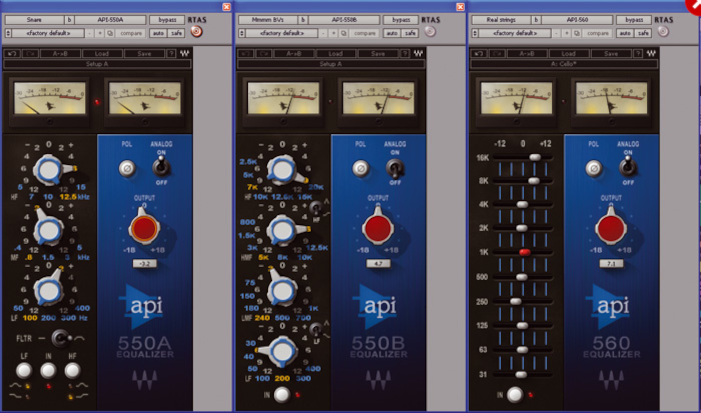Step into the world of unparalleled sound shaping with the API 550A and 550B EQ plugins, inspired by the iconic designs of the late 1960s. The API 550A EQ offers a unique approach to equalization with its 15 selectable points across 5 adjustable steps, allowing you to sculpt your audio with precision. Choose between peaking or shelving for both high and low frequencies, and enjoy the flexibility of an independent band-pass filter for tailored adjustments. Meanwhile, the API 550B shines with its four overlapping EQ bands, making it an essential tool for both correcting issues and enhancing your mix. With 7 selectable filter frequencies per band, the 550B’s innovative “Proportional Q” feature adapts the bandwidth dynamically, ensuring you achieve the perfect tonal balance. Effortlessly revert changes and explore a wide array of tonal options with these vintage-inspired plugins that deliver that unmistakable API character. The API 550A boasts 5 frequency centers per band with up to 12 dB of boost or cut in 2-3 dB increments, while the 550B offers 7 centers and similar boost/cut capabilities, with shelf and peak switching available on select bands. Both plugins are designed with high headroom, reaching a +30 dB clip level for maximum performance.
API’s Renowned Hardware Processors Go Virtual with Waves’ Plugin Bundle
API’s legendary hardware processors have transcended their physical forms and entered the digital realm, thanks to Waves’ latest plugin bundle. The Waves API Collection offers a state-of-the-art virtual emulation of three iconic API EQ models—the 550A, 550B, and 560—bringing the revered sound of API’s analog hardware into the digital world. Automated Processes, Inc., known as API, has been at the forefront of recording technology since its inception. They were pioneers in computer-controlled mixer automation and VCA technology, with their ‘60s and ‘70s desks becoming a benchmark for audio engineers worldwide. Their modular Lunchbox system is now a staple in outboard gear manufacturing, setting industry standards.
Software emulations of API hardware have appeared before, but the Waves API Collection stands out as the first officially licensed plugin bundle to capture the essence of API’s designs. This collection includes four plugins: three based on classic API EQ modules and a fourth that emulates the 2500 stereo compressor. These plugins are compatible with all major formats, making them versatile tools for both mono and stereo tracks. Waves has incorporated their signature features, such as the ability to switch between ‘A’ and ‘B’ settings for easy comparison.
Equal Rights: API’s EQ Plugins
The API EQ module circuits are renowned for their distinctive features. All of them use API’s proprietary 2520 opamp design, which is celebrated for its substantial headroom and forgiving performance even at extreme settings. The EQ modules implement ‘proportional Q’ design, where the width of each EQ band shifts automatically from broad to sharp depending on the amount of cut or boost applied. This design eliminates the need for independent control over band width, streamlining the EQ process. Additionally, the characteristic dual-concentric rotary knobs allow for compact and efficient control of frequency and gain.
The three EQ plugins in the Waves API Collection mirror the hardware’s front panels with remarkable accuracy. For the 550A and 550B models, which feature dual-concentric controls, Waves has smartly designed their plugins to allow adjustments via clickable frequency and gain legends, overcoming the limitations of mouse-based control. While these plugins don’t require presets, Waves includes numerous ones for added flexibility.
A/B Comparisons: Waves vs. URS
As a fan of URS’s A-Series plugin EQ, modeled after the API 550B, I was eager to compare it with Waves’ official, licensed version. In terms of usability, Waves’ interface proves superior with clearer distinction between frequency and gain selectors. However, URS’s bar-graph meters are arguably more informative than Waves’ virtual VU meters in a digital setting. Functionally, URS allows for gain adjustments in increments of 0.1dB, whereas Waves retains the original 2dB steps, which can significantly impact the sound. Despite this difference, the Waves plugins excel in delivering a rich and substantial sound. The 550A and 550B plugins both exhibit a distinctive character, with subtle differences in their output even with settings at 0dB.

Tone & Thrust: The API 2500 Plugin
Another highlight of the API Collection is the emulation of the 2500 stereo compressor. Though not a vintage unit itself, it incorporates technology from earlier API designs. The Waves API 2500 plugin has received high praise for its flexibility and sound quality. It features familiar controls such as Threshold, Attack, Ratio, and Release, with stepped settings for the latter three. The Release control also includes a secondary, continuously variable knob when set to its maximum, mirroring the hardware’s unique design.
The 2500’s standout feature is its Tone section, which includes controls for compression curves and sidechain filters. These filters tilt the entire frequency spectrum rather than just rolling off frequencies, offering a distinctive approach to dynamic processing. The plugin also allows for varying degrees of stereo linking between channels, providing nuanced control over how compression affects the mix.
In practice, the Waves API 2500 has become a go-to for mix compression, excelling in scenarios where other compressors might falter. Its ability to retain punch and impact, especially on dynamic or inconsistent tracks, is notable. The Tone controls significantly affect the plugin‘s response, making it versatile for different styles and applications.
Overall, the Waves API Collection plugins bring the revered API sound into the digital domain with exceptional accuracy and functionality. Whether you are using the EQ plugins or the 2500 compressor, these tools are designed to enhance your audio production with the classic API character that has been cherished by engineers for decades.


0 Comments